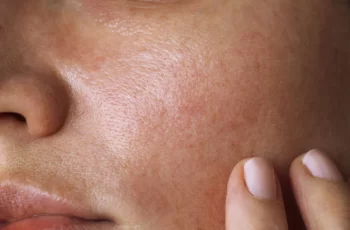
What Causes Crepey Skin–and Can You Prevent It?
Crepey skin is fragile, thin skin that has a paper-like texture. It is commonly found on the face, neck, lower eyelids, legs, and arms.
Common causes include sun damage, aging, and certain medications.
You can help prevent crepey skin and maintain skin health by eating nutrient-rich foods, protecting your skin from sun damage, and following a regular skincare routine to keep skin moisturized and supple.
What Does Crepey Skin Look Like?
Crepey skin is thin in appearance and has a papery look and feel. The name comes from its resemblance to crepe paper—a thin, wrinkly-looking paper used for decorating (e.g., party streamers) and crafts (e.g., paper mache).
Another sign of crepey skin is lax, loose-hanging skin. When the skin loses strength over time, its elasticity decreases and is less likely to bounce back into place.
What Causes Crepey Skin?
There are several causes of crepey skin, including aging, loss of collagen (the main structural protein found in the body’s skin and connective tissues), sun damage, fluctuations in weight, and certain medications.
Aging: As people age, the epidermis (outer skin layer) thins because the body produces less elastin. Elastin provides elasticity to the skin, allowing the skin to regain its shape after being stretched.10
Sun damage: Overexposure or lack of protection from the sun’s damaging ultraviolet (UV) rays can also make skin less elastic over time and ultimately accelerate skin aging.11
Weight changes: Frequent weight fluctuations or significant weight loss can also result in excess skin and reduced elasticity, leading to crepey-looking skin.
Medications: Frequent use of certain medications, such as corticosteroids, may cause skin atrophy (thinning) as a side effect. This reduction in skin thickness can cause a crepey appearance.
Risk Factors
A number of risk factors are associated with the likelihood of developing crepey skin. Older people and people with Ehlers-Danlos syndrome are more likely to have crepey skin. Ehlers-Danlos syndrome is a genetic disorder that affects collagen formation and function.13514
Drinking alcohol and smoking may also be risk factors. Research shows both are associated with changes in facial skin and volume that can lead to premature skin aging, increasing your risk of crepey skin.13
Crepey Skin Treatment
From home remedies to in-office dermatological treatments, you can try several treatment options to reduce the look of crepey skin.
At-Home Treatments
To care for crepey skin at home, try using both a skin-firming moisturizer and a retinoid (skincare derived from vitamin A). While firming creams can temporarily help plump skin, results are subtle and not a permanent fix for crepiness. Consistent use of the products is also necessary.
One study showed that using a firming body moisturizer twice daily on crepey upper arms for 12 weeks helped firm upper arms, reduce crepiness, improve skin thickness, and improve overall skin health and appearance. While the results are promising, the study was funded by a skincare company, so additional research is needed.
Retinoids boost collagen and speed up skin turnover, which may help reduce the look of mildly crepey skin.
American Academy of Dermatology Association. Retinoid or retinol?.
Crepey skin that is more prominent will require in-office dermatological treatments for best results.
In-Office Treatments
For in-office treatments, you should visit a board-certified dermatologist, a medical doctor who specializes in treating skin, hair, and nail conditions.
Laser Resurfacing
Laser resurfacing treatments use beams of light to tighten crepey skin. Recovery typically takes 5-7 days, and tightening effects begin to show within two weeks.
Ultrasound Skin Tightening
Ultrasound skin tightening is a non-invasive, collagen-producing treatment that uses ultrasound waves to tighten and lift the skin using heat.1One treatment will result in modest skin tightening and lifting within 2-6 months. Additional treatments may be necessary.
Fillers
Injectable skin fillers such as Radiesse (calcium hydroxylapatite) have a volumizing effect that can help improve upper arm crepiness.
Other fillers can help with eye crepiness, such as hyaluronic acid soft tissue fillers. Not everyone is a candidate for undereye filler, so you should see a dermatologist if you are considering it. They can assess whether filler or another in-office treatment is best.
Facial Threads
With this procedure, a cosmetic surgeon inserts special threads under your skin to pull back the extra skin. This gives the appearance of lifted, tighter skin. Facial threads also stimulate collagen and can help thicken and volumize crepey skin.
There are different types of threads to consider and potential complications to be aware of, so it’s best to discuss whether you are a candidate for this treatment with your healthcare provider.
Microneedling
Microneedling is a minimally invasive procedure that can rejuvenate the skin by encouraging collagen formation. Your provider will roll a tool covered in tiny needles across your skin, making little punctures. This does not damage the epidermis; they are controlled skin injuries that lead to wound healing and, in turn, skin rejuvenation.
Prevention
There are some helpful tips and lifestyle changes you can incorporate into your everyday routine to prevent crepey skin. Some science-backed ways to prevent crepey skin include:
Moisturize: Moisturize your skin every day using lotions, ointments, or creams to prevent dryness
Eat a nutritious, well-balanced diet: Eat nutrient-rich foods to prevent nutritional deficiencies that can cause skin changes, skin lesions, or rashes
Wear sunscreen: Protect your skin from UV light by applying a broad-spectrum sunscreen with a sun protection factor (SPF) of 30 or higher daily
Avoid tanning: Steer clear of tanning beds and sunlamps, which can cause skin cancer and accelerate skin aging
Avoid alcohol and smoking: Limit alcohol and smoking, both of which are associated with premature skin aging and changes in facial skin and volume
Take or use collagen: Oral collagen supplements and collagen-containing skincare products may help reduce or delay skin aging and wrinkling
Take a supplement with vitamin D3: Supplementing with vitamin D3 may help delay premature aging and prevent sun damage due to the vitamin’s anti-inflammatory properties and ability to inhibit DNA damage and promote DNA repair
A Quick Review
Crepey skin is paper-thin, fragile skin that appears saggy and loose. Internal and external factors can cause crepey skin, including sun damage, aging, changes in weight, loss of collagen, and some genetic conditions.
To help prevent crepey skin, protect your skin from the sun by wearing sunscreen whenever you’re outside, eating a diet full of nutrient-rich foods, avoiding tanning, and avoiding or limiting smoking and alcohol.
If you have crepey skin, you may want to consider adding a skin-firming moisturizer and retinoid to your regular skincare routine. Other treatments for crepey skin include laser resurfacing, ultrasound tightening, and facial threading. Speak to a dermatologist or other healthcare provider to discuss the best treatment for your skin.


